Agapanthus praecox



Soft wooded
No secondary (woody) tissue being formed. The texture is fleshy and is soft, easy to cut.
Clumping
A plant that when multiplies forms a clump.This variable clump forming rhizomatous perennial with fleshy roots and upright foliage forming a clump. It has dark green strap-like leaves and the blue or white funnel-shaped flowers appear in a rounded head above the foliage on a slender stem in summer.
Agapanthus praecox Willd. and its subspecies are naturally found from the Eastern and Western Cape to southern KwaZulu-Natal South Africa growing on mountain slopes and gullies from sea level to an altitude of 1,600 m (5,249 ft) or more. They grow in most well drained moderately fertile moist sandy, clay or loamy and chalky soils with a pH range from 5.5 to 7.5 but are adaptable. They prefer an open sunny to semi-shaded position and are light frost, salt spray and drought tolerant. They are also fire resistant and tolerate a minimum temperature of -6ºC (21ºF) but cannot withstand sustained frozen temperatures.
.
Agapanthus is grown for its clumping habit and its erect blue or white flower heads. It is planted along borders in small or cottage gardens or used in group or mass plantings in parks and large gardens. It is also planted along pathways or at the base of trees and can be cultivated in tubs and planter boxes. It is suitable for coastal positions or low-mountain regions in sub-tropical or Mediterranean regions and establishes from division in 1-2 years and is moderately long lived. This is an easy plant to cultivate and tolerates a wide range of conditions and neglect. The flowers are used in floral arrangements and seed heads should be removed as they may self-sow and the plant becomes weedy. It has a low water requirement once established (Scale: 1-drop from 3), responding to mulch in cold conditions and prefers reliable moist soil for optimum growth.
I.D. 87
UK hardiness zone H3
Climate zones 6 - 9, 12 - 24
USDA Zone 8-11
Agapanthus (ag-a-PANTH-us) praecox (pray-koks)
Etymology
Genus: Greek - Agapanthus –from ‘agape’ meaning (love) and ‘anthos’ meaning (flower) referring to the lovely flowers or the love of the flowers
Species: Latin – praecox – meaning (very early) referring to the early flowering period of the plant
Note:
It is also regarded as a weed in many regions as self seeds readily and is difficult to eradicate requiring the plant and roots to be removed.
subsp. praecox
This evergreen perennial grows to 1 m (3 ft) tall and is naturally found on the Eastern Cape and form clumps with 10 to 11 leathery textured spreading (not arching) leaves per plant. In its native habitat the medium blue flowers appear during late summer and have long perianth segments that are 50 mm (2 in) long or more.
subsp. orientalis “orientalis” meaning (from the east)
This evergreen perennial grows to 1 m (3 ft) tall and is naturally found from Eastern Cape and southern KwaZulu-Natal. It differs from the subsp. praecox by by having shorter perianth segments, more leaves per plant (around 20) that are not leathery and are arching. The flowers open in its native habitat during late summer and are pale blue or white forming a dense inflorescence.
subsp. minimus 'minimus' meanig (smallest)
This smaller evergreen perennial grows to 300 mm (1 ft) to 600 mm (2 ft) tall and differs from other subspecies by being smaller with fewer leaves per plant (around 10). The flowers have short perianth segments and fewer flowers are produced in the inflorescence. This earlier flowering subspecies will not form dense clumps and the open flowers are pale to dark blue or sometimes greyish-white.
Cultivars
Below are some of the cultivars contact your local nursery for available varieties.
'Albus'
This clump forming plant has dark green strap-like leaves and produces white flowers during summer. It grows in full sun to semi shade and tolerates most well drained soils. It has a low water requirement once established. (Scale: 1-drop from 3)
'Baby Blue' syn. Dwarf Blue or White
This dwarf plant grows 250 mm (9 ¾ in) to 600 mm (2 ft) tall forming clumps with strap-like leaves. It produces rounded flower heads that are cornflower blue during the warmer months of the year. It tolerates full sun to shaded positions on most well drained moist soils and is suitable for coastal positions. It has a low water requirement once established (Scale: 1-drop from 3) and responds to mulching and an occasional watering during dry periods.
'Black Pantha'
This clump forming perennial has dark green strap-like leaves and produces dark purple trumpet-shaped flowers that are arranged in a ball-like flower head held above the foliage on a tall stem appearing during late spring to early summer. It is used in border or mass plantings and is suitable for patio pots. It has a low water requirement once established (Scale: 1-drop from 3), responding to mulch and an occasional deep watering during dry periods.
'Flore-pleno'
This smaller clump forming plant produces double blue flowers during summer and grows in a full sun to semi shaded position. It prefers a well drained moist fertile soil but will tolerate most conditions. It has a low water requirement once established (Scale: 1-drop from 3) and responds to mulching and an occasional watering during dry periods.
'Maximus'
This strong growing upright plant form clumps and produces large blue flowers. It will grow in most soils and in most positions and It has a low water requirement once established (Scale: 1-drop from 3) and responds to mulching and an occasional watering during dry periods.
'Snowball'
This small perennial and grows to 400 mm (16 in) tall by 300 mm (1 ft) wide forming a clumping habit. It has a strap like to green leaves and produces pure white trumpet shaped flowers that are held above the foliage on a slender scape during early summer. It prefers an open sunny to semi shaded position, and grows in moderately fertile soils, tolerating dry conditions and coastal positions. It is planted in small gardens along borders for edging or may be grown in patio pots.
'Tinkerbell'
This clump forming plant grows to 800 mm (32 in) tall with strap-like leaves that are pale-green with cream margins. It produces violet blue flowers during summer and is an ideal plant for a rockery or edging pathways pool side planting. It grows in a full sun to semi shaded position on well drained soil. It has a low water requirement once established. (Scale: 1-drop from 3)
'Variegatus'
This clump forming plant has variegated white strap-like leaves and produces small blue flowers during summer. It prefers a full sun position on well drained fertile moist soils. It has a medium water requirement once established. (Scale: 2-drops from 3)
Other cultivars: 'Henryi', 'June Bond', 'Penn's White', 'Petite Blue', 'Queen Mum', 'Silver Streak', 'Storm Cloud', 'Winterdwarf'

South Africa (Eastern Cape, KwaZulu-Natal, Western Cape)
Agapanthaceae (ag-uh-PANTH- AY-see-ee)
Distribution
This monogeneric family of perennial tuberous herbs are found in the restricted region of southern South Africa.
Diagnostic Features
The distichous leaves are linear and basal normally with a fleshy texture.
The small flowers are bisexual and slightly zygomorphic and have 3 to 5 tepals arranged in a whorl. The 3-sepals and 3-petals are fused at the base and form a tubular shape. The 3+3 stamens are fused to the base of the tube. The flower have a superior ovary that is 3-locular with several ovules and has one hollow style.
The inflorescence is a terminal umbel-like and accompanied with 2-involucral bracts. It is normally held above the foliage on a tall scape.
The fruit is a loculicidal capsule that contains many seeds with a large embryo that is embedded in endosperm that contains aleurone oil.
Note:
These plants are used for general horticulture displays. There are 9 species worldwide with 1 genera.
Plant use: against a sunny wall, border planting, beach settings, bee attractive, commercial sites, coastal or mountainous regions, pots and tubs, courtyards, cottage gardens, cut flower, embankments, floral arrangements, garden escape, ground cover, low maintenance, mass planted,pathway borders, planter boxes, roof gardens, small gardens, sub-tropical, warm temperate, Mediterranean, suitable for California, Australia, United Kingdom, Sydney, Blue Mountains
This plant tolerates between USDA zones 8a to 11a and grows to 1 m (3 ft)
Fahrenheit 10º to 45º F
These temperatures represent the lowest average.
Celsius -12.2º to 7.2º C

Attention
This plant was last revised on the 1/05/2018
The information displayed on this plant is based on research conducted in our horticultural library and from reliable online resources. We also make observations of the plant that we photograph, and all care is taken to ensure the details are correct.
All photographs and data are covered by copyright. Apart from any fair dealing for the purpose of private study, research, reference or review, as permitted under the Copyright Act, no part including images and text may be reproduced by any means without written permission. The information presented in the map is only indicative and may contain errors and omissions. All inquiries should be addressed to sales@plantfile.com attention Peter Kirkland.
.

Simple
The leaf that is not divided.
Lanceolate
Broadest at the centre, three or more times long as broad (Lance-shape).
Basal
When the leaves grow from the base of the plant or radically from the root-shoot point.
Entire
A leaf margin with no irregularities (smooth).The glaborous dark green leaves are long-linear (strap-like) to lanceolate with a fleshy or leathery texture and are up to 500 mm (20 in) long by 50 mm (2 in) wide. The apex is acute and the leaves tend to arch and the upper surface has parallel veins.
Note: care should be taken as the leaves and roots contain clear sticky sap that if ingested causes nausea vomiting, abdominal pain and diarrhoea. The sap also causes skin irritation and rashes.


Funnelform
A flower where the petals form a funnel shape.
Umbel
When the pedicels arise from the same point on the peduncle.| Jan | Feb | Mar | Apr | May | Jun |
| Jul | Aug | Sep | Oct | Nov | Dec |
The bisexual funnelform flowers have 5-expanding petals with exserted stamens and are up to 50 mm wide (2in). They are arranged in a terminal umbel above the foliage on a long scape to 1.2 m (4 ft) tall and appearing from late spring to summer. The flower colour is vivid in either blue or white and is a reliable flowering plant.

Capsule
A dried dehiscent fruit, with an enclosing membrane normally containing may seeds."| Jan | Feb | Mar | Apr | May | Jun |
| Jul | Aug | Sep | Oct | Nov | Dec |
The large pendant 3-sided green-brown leathery capsule is up to 50 mm (2 in) long and contains numerous (20-100) flat black winged seeds with approximately 130 seeds per gram. The viable seeds can self sow and become a bush weed in some regions and the plant is normally reproduced vegetatively to maintain true to type.
Note: under cultivation the seed heads should be removed as they are unsightly and reduces risk of naturalization.
Agapanthus is grown for its clumping habit and its erect blue or white flower heads. It is planted along borders in small or cottage gardens or used in group or mass plantings in parks and large gardens. It is also planted along pathways or at the base of trees and can be cultivated in tubs and planter boxes. It is suitable for coastal positions or low-mountain regions in sub-tropical or Mediterranean regions and establishes from division in 1-2 years and is moderately long lived. This is an easy plant to cultivate and tolerates a wide range of conditions and neglect. The flowers are used in floral arrangements and seed heads should be removed as they may self-sow and the plant becomes weedy.
Note:
It is also regarded as a weed in many regions as self seeds readily and is difficult to eradicate requiring the plant and roots to be removed.
Sow fresh seed during spring in a well drained media, keep moist and maintain a temperature of 19º to 27º C. (66º to 81º F). Plantlets take 3 to 4 years to come to flower.
Divide the clump from winter to early spring and reduce the foliage by 50%.
Propagation by Seed (General)
Germination
In order for a seed to germinate it must fulfil three conditions.
1. The embryo must be alive (a viable seed).
2. The seed must have no dormancy-inducing physiological, physical or chemical barrier to germination; also the seed must be nondormant.
3. The seed must have the appropriate environmental requirements, water, temperature and oxygen.
The interaction between these requirements and dormancy is complex and may lead to different environmental requirements that avoid the dormancy of a seed.
Sowing Seeds in Containers
There are two general methods for germinating seeds.
1. Sowing seeds in a flat or germinating bed, through which seedlings are pricked-out then, transplanted into another flat with wider spacing or directly to an individual pot.
2. Sowing seeds by placing them in to flats with the appropriate spacing or into individual pots.
This method is normally carried out with medium to large seeds such as woody plants and plants that are difficult to transplant.
Seedling production normally occurs in a greenhouse / glasshouse, cold frames and on hot beds.
Method of Seed Sowing
Fine seed is sown in pots or flats that are no deeper than 70 to 80 mm. using a sterilised well-drained media (soil). Fill the container to 20 mm from the top and sprinkle sieved peat to 3 mm depth.
Press the media down level and firm with a piece of timber and then thoroughly moisten.
Mix the fine seed with washed sand and then sow thinly on the surface. These may be lightly covered with sand.
Larger seeds may be covered with media or a hole is dibbled and the seed is placed in the media.
Watering Methods
For watering you may either mist the containers from above or place the container in tepid water and allow the water to raise through the pot to the surface of the media, then drain away and do not fill to the top of the container.
Place a piece of glass over the pot and store in a protected warm environment (glasshouse).
Seeds germinate best in darkness so shade the containers if in direct sunlight.
After the seedlings have sprouted remove the glass and ease the seedlings into direct light.
When the seedlings are large enough prick them out and transplant into larger containers and place them in a shade house to harden off.
Many seeds have different methods of seed preparation for germination such as nicking or cutting the seed coat to allow water penetration, also placing seeds in hot water and allowing it to cool off.
This is particularly important as it is softening the seed coat.
Layering (General)
Factors associated with layering.
1. Nutrition.
The stem is still attached to the plant and the intact xylem supplies water nutrition. To initiate roots on an intact stem requires certain factors.
2. Stem Treatments.
Adventitious roots are induced by the interruption of downward flow of nutrients and organic material from the leaves. Roots occur as if it is a cutting.
3. Light Exclusion.
The best results occur with the stem continuously being covered with rooting medium.
Blanching; the covering of a stem that has already formed.
Etiolation; the growing of the stem (elongating) due to the absence of light.
Both of these methods are employed either singularly or together and may require phloem interruption to induce root formation.
Physiological Conditioning
Timing of root induction normally occurs at the end of the growing season as the carbohydrates are moving towards the roots.
Root formation depends on, continuous moisture, ample aeration and a moderate temperature in the rooting area.
Uses of Layering
1. To propagate plants that is naturally layer.
2. To propagate plants that doesn't root easily as cuttings.
3. To produce a large-size plant in a short time.
4. To produce a small number of good size plants with minimal propagation facilities.
Methods of Layering
Tip Layering
This method is used on plants that produce long arching canes. The tips of these canes are placed into a hole that is sloped on one side towards the plant. This is method is carried out towards the end of the growing period. The shoots are buried facing the blunt end of the hole.
The etiolated shoot form roots and a new vertical shoot occur.
Simple Layering
This type of layering is carried out during early spring with dormant one-year-old shoots or during autumn with mature new growth.
The branches are bent over to the ground and pegged in a hole. Root stimulating may be induced with, girdling, wiring, bending and notching.
The roots are produced through the first season and may be severe and lifted during autumn or the following spring.
It is advisable to stack the emerging shoot to maintain a good shaped plant.
Compound or Serpentine Layering
This is a simple layering method where the flexible stems are covered and exposed then covered again. This will produce several plants from the one branch.
Air Layering
This method is used to propagate tropical and sub-tropical plants. It is carried out during spring on the previous season's growth or in tropical conditions after the first new leaves are produced.
First; girdle or remove the bark on the stem about 20 mm (¾ in) long and ensure that the phloem and cambium is removed. Place sphagnum moss over the exposed branch and then covered with a piece of polyethylene film so that the folds join is facing down. The two ends are twisted around the branch and tied or taped up the branch so the water cannot seep in.
Aluminium foil may be also used for this procedure. The layer should be left till autumn, though this will depend on the growth rate of the plant.
When removing from the parent plant reduce the top part of the foliage in relation to the root size then pot up and place in a moist humid environment (misting bench). Harden off in a few weeks.
Mound Layering
This form of propagation is used in the production of rootstocks for, apple, pear, quince and gooseberries. The mother plant is planted in a small trench in rows one year before layering takes place.
The next spring the plants are cut back to ground level. Three to five shoots appear and when they reach 15 cm (3/5 in) a mixture of sawdust and loose soil is mounded half way up.
This action is carried out twice more, when shoots reach 30 cm (1 1/8 in) and during mid summer. In all cases the mounding should not exceed half the total hight of the shoot. Girdling 6 to 8 week into the growing period will encourage Roots to occur in the mound.
Layered shoots are cut away from the mother plant during autumn and planted in a nursery row.
Trench Layering
This is a form of layering used for woody plants that are difficult to root in mound layering. The method involves the mother plant being planted in a trench on a 30 deg. angle one year before layering.
The following year the plant is bent over and pegged in the trench flat. As new vertical shoots appear during spring they are systematically buried before the buds swell with a rooting medium of peat or sawdust soil mix. This causes etiolation and a second layer of medium should be applied to the shoots before the buds expand.
When the shoots reach 20 cm (¾ in) a final layer of medium should be applied.
At the end of the season the rooting medium is removed and the rooted shoots are cut from the mother plant.
Natural layering
Runners
These are stems that grow horizontal from the mother plant and form new plants from a node that form its own root system. When these daughter plants root up in the soil they are dug up and planted as a new plant.
Stolons
These are modified stems that grow horizontal to the ground or under the ground with nodes that can produce new plants as in a potato tuber. These can be cut away from the mother plant and form a new plant.
Offsets
This is a lateral shoot that forms from at the base of the mother plant. Often referred to in bulbs as bulblets or lateral branching in monocotyledons, which appear as thickened stems and are removed close to the main stem. These natural methods are slow but microporpagation in aseptic culture has greatly enhanced production.
Suckers
The true meaning of a sucker is a shoot that comes from an adventitious bud on the roots, but generally it is referred to any shoots that arise from the crown of the plant. A sucker may be also seen as any shoot on a rootstock that is below the grafted section.
The method of removal is to dig out and cut it away from the mother plant with some roots attached to its base. It is then treated as a cutting, potted up and kept moist. This operation is normally carried out during the dormant period of the plant.
Crown Division
The crown is the part of the plant at the surface of the soil where new shoots arise. With lateral shoots the crown of some plants requires division when they become crowded.
Herbaceous perennials and multi-branched woody shrubs may develop large crowns that need dividing.
It is a simple method of propagation that is used by amateurs and professionals for a small increase in plants.
Plants that flower during spring to summer are divided during autumn and if flowering in summer to autumn they are divided in spring. The crown is dug up and cut with a knife in to sections, which has a shoot and abundant roots then planted or potted up. The crown may also be divided in some species by using a shovel to cut and dig sections out.
PEST
NAME
Aphids
Various Aphid Species
ORDER
Hemiptera
FAMILY
Aphididae
Description of the Pest
The common name varies and aphids may be referred to as black fly, greenfly, ant cows or plant lice.
These small insects have soft globular body that is from 1mm to 8mm long and vary in colour from green, yellow, black and pink, with the winged forms being elongated. Both adult and nymphs, have piercing and sucking mouthparts.
Aphids are found on buds, flowers, or leaves and stems, preferring soft new growth. On older leaves the aphids are found in protected positions, such as under the leaf. Certain species of aphids form galls as they suck sap and may be found on the roots of the plant. (E.g. Woolly aphids and Black peach aphids)
Most aphids possess a pair of characteristic tubular projections, known as cornicles; these secrete a pheromone and a waxy fluid, which is thought to protect them from some of their predacious enemies.
White exoskeletons, honey dew and sooty mould indicate the presence of Aphids
Balsam Twig Aphid (Mindarus abietinus) is greenish and covered in a white wax and is normally found on the young shoots of conifers bending and killing the needles. It is found on Abies and Picea species.
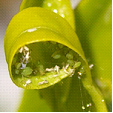 Aphid and their exoskeletons
Aphid and their exoskeletons 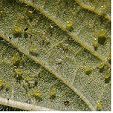 on underside of a leaf
on underside of a leaf
Black Citrus Aphid (Toxoptera aurantii) has a soft plump green body and the black coloured adults may or may not be winged. They feed in groups, curling leaves and producing honeydew attracting sooty mould.
Green Peach Aphid (Myzus persicae) is a soft plump green insect up to 0.2mm long and may be wingless. The nymphs are yellowish green and are responsible for spreading viruses in Dianthus species.
Spruce Gall Aphid (Chermes abietis) form cone shaped galls up to 12mm long resulting from the feeding. The wingless female adult lays eggs on the stems and the immature females overwinter on bud scales. Large infestation will weaken trees such as Picea abies and Pseudotsuga menziesii.
Tulip Bulb Aphid (Anuraphis tulipae) is small, waxy grey coloured and infests the underside of the bulb scales or rhizomes. They occur in the ground or on above ground parts and during storage.
Life Cycle
These insects have a Hemimetabolous life cycle, i.e. The nymphs resemble the adults.
During spring all eggs produced hatch as female nymphs. Adult Aphids are capable reproducing without fertilisation. The males are only produced in some species as the weather cools down, and the day length shortens.
Aphids are capable of giving birth to living young and large populations build up quickly during summer. Over crowding causes the aphids to become smaller, less fertile and produce more winged forms that can migrate to other host plants.
There are many different types of aphids and the life cycle varies from warm to cold climates.
Typical life cycles
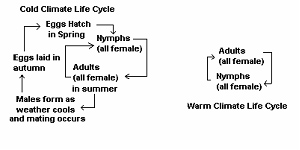
Distribution of the Pest
World wide
Period of Activity
In warm climates they are seen throughout the year, but aphids dislike hot dry or cold conditions and heavy rain will decrease the population. In cold areas aphid eggs are laid around a bud base or other protected areas of the plant during autumn and emerge as nymphs during spring, feeding on the new growth.
Numbers build up quickly in the warmer months of the year. Some species feed during winter on Sow thistles.
Susceptible Plants
There is a wide range of plants attacked, from roses to vegetables, shrubs and trees. Certain aphids attack a specific genus while others have a wide range of host plants. Many are capable of transmitting plant virus diseases.
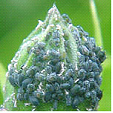 Adults and nymphs feeding
Adults and nymphs feeding 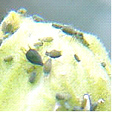 A colony of aphids
A colony of aphids
Acer species are attacked by several aphids including the Norway Maple Aphid (Periphyllus lyropictus) which is a greenish with brown markings and secret honeydew, preferring Acer platanoides. Other aphids include (Drepanaphis acerifolia) and (Periphyllus aceris) which are commonly found on the underside of leaves.
Acer species are also attacked by the Woolly Maple Aphid (Phenacoccus acericola) which covers the undersides of the leaves with a cotton-like mass
Alnus species are infested with the Alder Blight Aphid (Prociphilus tessellates) which is blue-black adult that forms woolly masses on the down-turned leaves. The nymphs overwinter in bark crevices.
Aquilegia species are attacked by several aphids including (Pergandeidia trirhoda) which is a small, flat cream coloured insect that is found on young branches and the underside of leaves.
Betula species may be attacked by the European Birch Aphid (Euceraphis betulae) which is small and yellowish or the Common Birch Aphid (Calaphis betulaecolens) which is large and green producing ample honeydew for sooty mold to grow on.
Callistephus species may be attacked by the Corn Root Aphid (Anuraphis maidi-radicis) causing the plant to become stunted, the leaves wilt and turn yellow. The aphids feed on the roots producing honeydew and are dispersed to other host by ants. It is also attacked by the Potato Aphid (Macrosiphum solanifolii).
Carya species are attacked by Gall Aphids (Phylloxera caryaecaulis) which is found on the leaves, twigs and stems forming galls and turning them black.
Chaenomeles and Gladiolus species, new growth and leaves become infested with the aphid (Aphis Gossypii)
Cupressus macrocarpa may become infested with the Cypress Aphid (Siphonartrophia cupressi).
Cyclamen species are attacked by the aphid (Myzus circumflexus) and (Aphis gossypii) which can infest healthy plants.
Dendranthema, Dianthus and Crocus species are attacked by several types of aphid including the Green Peach Aphid (Myzus persicae) and the Chrysanthemum Aphid (Macrosiphoniella sanborni).
Hibiscus species are attacked by the aphids (Aphis craccivora) and (Aphis gossypii), both congregate towards the branch tips and may cause leaf curl. Normally only seen in sub-tropical climates.
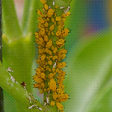 Aphids on a stem
Aphids on a stem 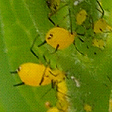 Mandevilla species
Mandevilla species
Larix species is attacked by the Woolly Larch Aphid (Adelges strobilobius). The winged adults deposit eggs at the base of the needles during spring and white woolly areas appear attached to the needles where the adult aphids feed. The young aphids overwinter in the crevices of the bark.
Mandevilla species is attacked by aphids that congregate towards the branch tips and may cause leaf curl.
Pinus species is attacked by several species of aphid including Pine Bark Aphid (Pineus strobi), Pine leaf Aphid (Pineus pinifoliae) and the White Pine Aphid (Cinara strobi).
Primula species are attacked by four species of aphid including foxglove, and green peach aphid.
Rudbeckia, Delphinium, Chrysanthemum and Helianthus species are attacked by a bright red aphid (Macrosiphum rudbeckiae).
Sorbus aucuparia is affected by the Rosy Apple and Woolly Apple aphid which attacked the foliage and young shoots.
Spiraea species are attacked by the Aphid (Aphis spiraecola) which feeds on the young shoots and flowers.
Tropaeolum species are attacked by the Black Bean Aphid (Aphis fabae), which is found in large numbers on the underside of the leaves, turning them yellow and causing them to wilt then die.
Tulipa, Iris, Freesia, Gladiolus and Zephyranthes species are infested with the Tulip Bulb Aphid.
Ulmus species are infected by two types the Woolly Apple Aphid (Eriosoma lanigerum), which curls and kills young terminal leaves and the Elm Leaf-Curl Aphid (Eriosoma ulmi) which occasionally attacks the trees.
Viburnum species are attacked by the Snowball Aphid (Anuraphis viburnicola). This aphid congregates at the end of the branches causing the leaves to curl and become deformed under which they hide.
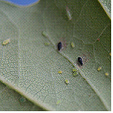 Aphids on Quercus robur
Aphids on Quercus robur
Damage Caused
Buds that have been attacked may not open, leaves and twigs become twisted or distorted and wilt. The aphids also produce honeydew, which is sticky and attracts sooty mould (fungus). This fungus forms a thick layer over the leaf, fruit or stems reducing the plants photosynthesis capability. The sooty mould spoils the plants appearance and its fruit, as does the insects white exoskeletons.
Control
Cultural Control
Aphids may be removed from a plant by hosing them off with water (limited success) or applying soapy water to aphids.. Another organic sprays can be efficient in controlling aphids. Aphids may also be removed physically by hand for small colonies on spine less plants. Species that live under ground are difficult to control but cultivation of the surrounding soil may help in controlling the infestation. (limited mainly to annual or commercial crops)
Reflective mulch around the plants also reduces numbers by repelling the insect this material is available commercially. (Reflective mulches are mainly used in market gardens for avoiding the Green peach Aphids) Resistant rootstocks are available to avoid some root feeding aphid of commercial plants, e.g. Vines and fruit trees
Biological control
Aphids are attacked by several insects includes parasitic wasps or predators such as ladybirds/ lady beetles, hover flies, lacewings, spiders.
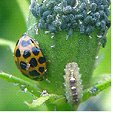
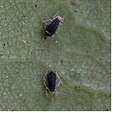 Parasitised aphids
Parasitised aphids
Chemical Control
Aphids may be controlled by spraying with a contact or systemic insecticide. The type of application used will depend on the plant is being attacked.
Aphids can be suffocated and therefore controlled with the use of e.g. White oil, Pest oil, Soapy water from soap such as Lux Flakes ®
Note
It is your responsibility by law to read & follow the directions on the label of any pesticide
Monitoring
Aphid are attracted by yellow colour and traps such as boards painted yellow and covered in glue or sticky substance will attract and trap the insects. There is also a commercially sticky yellow tape that can be attached to susceptible plants
Amendments by B. Sonsie Dip Hort Sc Burnley
PEST
NAME
Slugs and Snails
Various Snails Species
Description of the Pest
Slugs and snails are land molluscs. Snails produce an external spiral shell; slugs do not. The common garden snail Helix asperasa, grows up to 25 mm, long. Its body is slimy, broad, elongated and greyish, with two pairs of reticulated tentacles, with eyes at the ends of the longer pair. The mouth parts of snails and slugs contain a file-like organ known as the radula, which is used to rasp away at the host plant's tissue. Movement of the animal is by a muscular sliding movement, along a slippery trail of mucous; this solidifies on exposure to the air (typically described as a "silvery trail").
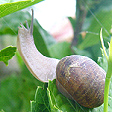
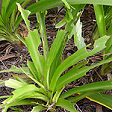
Appearance and Distribution of the Pest
Slugs and snails occur world-wide. Slugs tend to be more prevalent in heavier soil types.
Life Cycle
These insects have a Hemimetabolous life cycle, ie. When the immature nymphs resemble the adults.
Snail eggs are laid in moist soil, 20-40mm deep; eggs are white, spherical and appear in clusters of 30-100. Under favourable conditions, eggs hatch in 2-3 weeks. Newly emerged snails resemble tiny adults. When the weather is cold and dry, snails seal themselves into their shells where they survive, dormant, for 1-3 years.
Period of Activity
More active during the warmer months, although some species may remain active throughout the year.
Damage Caused
Native Australian slugs and snails are not commercial pests. Introduced species chew holes in foliage or skeletonise leaves; some plants may be completely defoliated plants; tubers and seedlings may be completely eaten. Slugs and snails feed mainly at night, especially after rain or watering; they shelter in cool, moist locations during the day. When the weather is dry, snails seal themselves into their shells with a mucous membrane, where they survive, dormant, for 1-3 years. Some species may consume up to one third of their body weight each day.
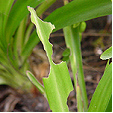
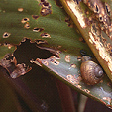
Susceptible Plants
A wide range of leafy plants, including ground crops, potatoes, tubers, leafy vegetables and seedlings.
Fern species are attacked causing serious damage. New fronds are repetitively eaten causing the plant to become stunted. Attacks are normally more severe during wet periods during which time control measures should be taken.
Morinda citrifolia is attacked by the Giant African Snail (Achatina fulica) which defoliates trees.
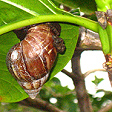
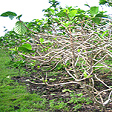
Cultural Control
Remove possible hiding places and avoid overhead watering to reduce humidity. Cultivate soil regularly; in commercial situations, allow the soil to remain fallow for one season to reduce numbers. Domestic infestations may be removed by hand. Traps may be created by inverting small pots near where snails and slugs are feeding; they will gather in these shelters during the day, and may be collected and destroyed. The popular Australian "beer trap" consists of a vertically-sided container, sunk into the ground and filled with beer, which intoxicates and drowns the snails.
Biological Control
Natural predators such as birds, frogs, and lizards reduce numbers, but do not provide effective control. Orchardists have used running ducks to control snails with some success.
Chemical Control
Commercial baits - molluscicides - made from methiocarb or metaldehyde are effective when used in combination with sanitation. Their effectiveness varies according to soil and weather conditions; it is generally recommended to avoid watering after application.
Note
Always read the label for registration details and direction of use prior to application of any chemicals.
Note: Plants affected by this pest are the Rabbit Resistant plants not the susceptible plants.
PEST
NAME
Rabbits
Oryctolagus cuniculus & Sylvilagus species
ORDER
Lagomorpha
FAMILY
Leporidae
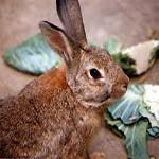
Description of the Pest
There are a eight different genera in the family classified as rabbits and include the European Rabbit (Oryctolagus cuniculus) which has infested Australia and the Cottontail rabbit (Sylvilagus spp.) which consists of 13-species with 9-species found in North America.
Generally rabbits have an egg-shaped body that can range in size from 200 mm to 500 mm long and weigh up to 2 kg. They have long ears that are adapted for detecting predators and powerful large hind legs allowing them to move fast. The body is covered in buffed, long soft fur that is brown or grey and the mouth has two sets of incisor teeth which are located one behind the other.
The cottontail rabbit grows up to 450 mm (18 in) tall and weighs 1.36 kg (3 lbs).
Appearance and Distribution of the Pest
Generally rabbits live in a variety of habitats including meadows, woodlands, forests, grasslands or deserts and wetlands living in groups with some underground in borrowers. The European Rabbit has been introduced to many parts of the world and in 1859 Thomas Austin brought 24 breeding pairs to Australia which subsequently escaped and quickly bred throughout Victoria and New South Wales and by the 1900's the rabbits had reached the Northern Territory and Western Australia.
Life Cycle
The life span varies with each species. Cottontails for example can live for one year to a maximum of three years in the wild but in captivity they can last for eight years, during which time they can raise between 2-6 litters per year and produce up to 18 kittens during the breeding season. In the cooler northern parts of North America the size and number of litters are generally smaller only 2-3 but in southern regions such as Mexico or Australia, European rabbits can produce 5-6 litters per year, normally commencing during spring time and continuing throughout the year. Each litter can consist of 2-8 or more kittens. Under ideal seasonal conditions a mature doe (female) can mate again several hours after giving birth and has a gestation period from 28-30 days.
Period of Activity
Generally rabbits eat throughout the year but in cooler countries such as North America they are more active during the spring to summer period but in warmer climates such as Australia rabbits can cause significant damage throughout the year.
Damage Caused
in Australia the effects of rabbits on the landscape has been a devastating resulting in the loss of an unknown number of plant species and a ring barking of young trees in orchards or forests. Major erosion problems have also resulted from warrens or plant denuded landscapes which are left vulnerable to the elements.
A rabbits generally will eat most flowers or the bark of woody plants, grasses of all types and most agricultural crops (vegetables).
Susceptible Plants
Rabbits mainly consumed grasses or garden vegetables and a broad range of ornamental plants. In cool climates where snowfalls rabbits eat twigs, bark and buds from the dormant plants. When rabbits are hungry they will eat most plants but attached to this file are rabbit resistant plants that are less palatable. Their resistance will vary depending on the stage of growth as new shoots are very desirable to rabbits.
Cultural Control
Control methods include trapping, hunting and exclusion with the use of fences, all of which had a marginal success. Many predators utilise rabbits as a food source for example foxes, feral dogs and cats, hawks or owls and human hunters.
Biological Control
In Australia to biological diseases have had reasonable success. In 1950 Myxomatosis was released into the rabbit population and resulted in the numbers dropping from 600 million to 100 million. Remaining populations became immune and steadily increased numbers to 300 million by the 1990s. The calicivirus was accidentally released in 1996 and culled populations significantly in regions of extreme heat but was less effective in cooler regions where the rabbits were exposed to a lesser calicivirus that immune them.
Chemical Control
Baiting and chemical repellents programs relied on the territorial habits of rabbits as they rarely forage further afield from their territorial areas.
Note
Landholders should seek advice from their local government agencies. This advice will include fumigation or destruction of warrens, fencing and shooting.
DISEASE
NAME
Phytophthora Rot
Phytophthora species
Pathogen Name
A number of Phytophthora species cause these diseases but the most important species in Australia is the cinnamon fungus, Phytophthora cinnamomi. This species is exotic to Australia and probably originated from south east Asia; it has probably been present in Australia for close to 200 years. Phytophthora are fungal-like organisms that are related to some protozoa and algae; they are microscopic and cannot be observed by the naked eye.
Description
There are many types of Phytophthora Rot but generally the disease affects the plant by causing a soft rot of the affected plant part. The most common form of the disease is a rotting of the roots that occurs below ground with no visible symptoms of the disease above ground until the disease starts to cause leaf drop.
Symptoms
The disease is initiated below ground in the soil, usually on the feeder roots of a plant. The pathogen grows through the roots killing cells and eventually causing an extensive root decay. This causes the infected plant to lose vigour and the leaves to yellow and die. Entire branches starting from the top then die, quickly during hot weather or linger for months. The infection occurs on the root hairs causing small and large roots to rot. The symptoms of the disease are often very difficult to differentiate from drought symptoms, mainly because the affected root system prevents the uptake of moisture from the soil. Once the disease has progressed far enough large branches will die causing the typical dieback symptoms.
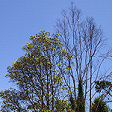
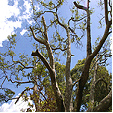
There are a number of other diseases caused by Phytophthora species
Twig Die Back (Phytophthora ilicis) attacks Ilex species causing black leaf spots and black stem cankers.
Phytophthora cactorum is known by several common names depending on which plant is being attacked and they have various symptoms. Plant species are listed below.
Root Rot (Phytophthora richardiae) infects Zantedeschia species causing the leaves to turn yellow, wilt and die. Flowers are deformed if they bloom and the infection can also be seen in the new growth, eventually killing the plant. On inspection the roots show signs of decay.
Stem Rot (Phytophthora cryptogea) infects the roots and stems turning them brown and seeds are also attacked causing decay. It is commonly found on Tagetes erecta and infected plants wilt, collapse and die.
Source and Dispersal
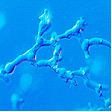 Sporangia
Sporangia 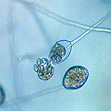 Zoospores
Zoospores 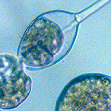
Image by Dr Brett Summerell
Phytophthora species produce sporangia that contain specialised zoospores that have flagella that allow them to move through the soil moisture small distances. These spores encyst on the root and then penetrate the root. The pathogen also produces chlamydospores, specialised survival spores that allow it to survive in the soil for extended periods of time. The chlamydospores can be transported in soil, even extremely small amounts, allowing the pathogen to be dispersed very easily throughout an area and from one location to another. The zoospores are easily moved in water flowing through soil and so are easily dispersed down slopes. It is not uncommon for the disease to move in fronts down a slope.
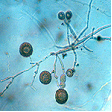
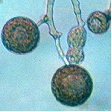 Chlamydospores, specialised survival spores
Chlamydospores, specialised survival spores
Image by Dr Brett Summerell
Favoured Conditions
Phytophthora root rot is favoured by poorly drained soils or in soils that are waterlogged for short periods of time. The disease generally occurs during periods when the temperature is above 16ºC although it has been observed in snow gum country in the Barrington Tops National Park and in southern Tasmania. It also prefers soils that have little organic material.
Affected Plants
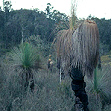
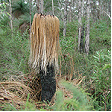 Xanthorrhoea species
Xanthorrhoea species
Image by Dr Brett Summerell
The host range that is attacked by Phytophthora cinnamomi is enormous and is still not well understood but includes many Australian native plants, Rhododendrons, Acer and Prunus species, conifers, cabbage tree and strawberries. Some Australian plant families that are quite susceptible include species in the Proteaceae, Epacridaceae and Xanthorrhoea species.
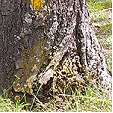 Alphitonia excelsa
Alphitonia excelsa
Alphitonia excelsa can be infected by Phytophthora cinnamomi causing loss of foliage, death of the upper branches and cankers on the trunk.
Cactus such as Cereus species may be infected with Slimy Collar Rot (Phytophthora cactorum) which forms a soft black area at the base of the plant that is water soaked.
Chamaecyparis species may be infected with the Root Rot (Phytophthora lateralis) that attacks roots, trunk, stems and leaves.
Cornus species are infected by Crown Canker (Phytophthora cactorum) and in this case the tree is partially infected initially with one side producing smaller leaves that turn reddish in late summer. The leaves may also shrivel and die prematurely, during dry periods and small and large branches die. After a couple of seasons the tree becomes completely infected with poor top growth and an inconspicuous canker develops at the base of the trunk. Eventually the tree dies.
Erica species are infected by (Phytophthora cinnamomi). The symptoms include foliage turning greyish towards the top, and then the plant wilts then dies with evidence of infection at the base.
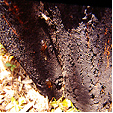 Phytophthora in Eucalyptus species
Phytophthora in Eucalyptus species
Image by B. Sonsie
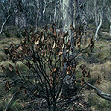
Image by Dr Brett Summerell
Eucalyptus species are infected by Phytophthora cinnamomi causing rapid die back of the tree with blackened trunk loss or upper growth and is a serious problem for certain species such as Eucalyptus diversicolor (Karri).
Euphorbia pulcherrima is susceptible to Root Rot (Phytophthora and Pythium species). Roots become dark and the rot can extend up the stem. The plant is also susceptible to leaf blight resulting from the same fungal disease.
Hedera species are infected by Phytophthora Blight (Phytophthora palmivora). This fungus causes leaf spots, foliage blight and stem rot.
Palms such as Archontophoenix, Caryota, Chamaedorea, Cocos, Dypsis, Howea, Liculia, Linospadix, Livistona, Phoenix, Ptychosperma, Rhapis, Roystonea, Syagrus, Washingtonia and Wodyetia species are also susceptible to Phytophthora Blight forming large irregular areas on the fronds that become dark and rotten and limited by the veins
Lilium species are infected by Foot Rot (Phytophthora cactorum) which attacking the stems just below the soil level causing the plant to topple and if infection occurs as the leaves are emerging the base of the infected leaves which collapse remain attached to the bulb.
Morinda citrifolia is infected by Phytophthora Blight, black flag disease (Phytophthora species) which causes the foliage to turn black and limp. The fruit and stems are also infected causing them to turn brown-black and whither.
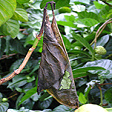
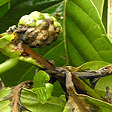 Morinda citrifolia
Morinda citrifolia
Orchids such as Cattleya, Cymbidium, Cypripedium, Dendrobium, Epidendrum, Paphiopedilum, Phalaenopsis and Zygopetalum species are infected by Black Rot (Phytophthora or Pythium species). This causes the leaves, pseudobulbs, rhizomes and roots to form a dark soft rot, normally occurring towards the base of the plant.
Saintpaulia, Dianthus, Gypsophila, Limonium and Anemone species are infected by Root and Crown Rot (Phytophthora nicotianae). This is a fast moving fungus that turns the roots blackish then extends to the crown and petioles causing wet rot of the crown then wilting, eventually killing the plant. When found as Phytophthora Leaf Spot or Blight, angular spots appear with water-soaked margins as in Cordyline and Philodendron species.
Sedum species can be infected by up to three Stem Rot fungi including (Colletotrichum species), (Phytophthora species) and (Pellicularia filamentosa). Commonly occurring in wet soils.
Ulmus and Acer species are also infected by (Phytophthora cactorum) and this is known as Bleeding Canker. This casual disease initially causes cankers in the bark that ooze sap and the sapwood forms reddish lesions with greenish margins. The leaves on affected branches turn yellow, wilt then die and mildly affected trees may survive.
Many species are infected by the Bleeding Canker including Acer platanoides, Acer rubrum, Acer pseudoplatanus, Acer saccharinum, Betula species, Liquidambar styraciflua, Aesculus x carnea, Tilia, Salix and Quercus species.
Non-chemical Control
The most effective control for all Phytophthora diseases is prevention primarily because it is extremely difficult to control Phytophthora diseases after they are established in the plant. As Phytophthora species are most easily transported in infested soil quarantine is an essential component of control of the disease and it is for this reason many areas have hygiene protocols to stop the pathogen being introduced into an area. It is recommended that bush walkers take care not to introduce the pathogen on their boots into un-infested areas and for this reason it is suggested that walking boots be cleaned and preferably sterilised (with 70% methylated spirits) prior to starting a walk.
Cultural techniques such as cultivating the soil regularly with added animal manure and other organic substrates to ensure there is good drainage will also help to minimise the impact of the disease. The plants can be mulched with straw or other organic material taking care that the base of the trunk is left clear. Avoid over watering the soil and observe hygiene in regards to tools, containers or shoes to reduce spreading the infection.
Potting mixes should be pasteurised for 30min at 60ºC to ensure that they are free of the pathogen. It is also very important to grow pots off the ground to prevent the splash of infested mix or water from an infected plant to clean plants.
.
Avoid damaging the bark particularly at ground level and seal any wounds that occur. If cactus or tree species are infected it is possible to cut out the infected area when first seen in order to contain it. Correct tree surgery techniques are required for large trees.
Chemical Control
There are a number of fungicides that are registered for use in the control of these diseases. The most effective chemical control are based on the use of chemicals containing potassium phosphonate. This chemical effectively enhances the defence systems of the plant and has been shown to be most effective in controlling Phytophthora diseases. It is essential that the chemical be applied when the plants is exporting nutrients to the roots, so this is best in the warmer months. The chemical can be applied as a stem injection or a foliar spray, and in some situations as a soil drench. There are specialised stem injecting equipment available for stem injections on larger trees.
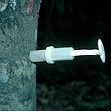
Image by Dr Brett Summerell
Note
Always read the label for registration details and direction of use prior to application of any chemicals.
Amendments by
Dr Brett Summerell
Director Science and Public Programs
Royal Botanic Gardens Trust, Sydney
Average Lowest Temperature : -1º C 30º F
USDA : 8, 9, 10, 11
This USDA (United States Department of Agriculture) hardiness zone chart can be used to indicate a plant’s ability to withstand average minimum temperatures. However, other factors such as soil type, pH, and moisture, drainage, humidity and exposure to sun and wind will also have a direct effect on your plant’s survival. Use this chart only as a guide, always keep the other factors in mind when deciding where, when and what to plant.
A plant's individual USDA zone can be found in the Plant Overview.
Climate Description
Warm to Sub-tropical
This overlaping zone has ample rain with high summer temeperatures and high humidity. Winters are mild. Pockets of sub-tropical climates exist within coastal warm temperate zones.
Frosts and droughts rarely occur along the coast.
Plant growth
Tropical and warm temperate native and exotic plants grow well.
| Dictionary | Growth Habit |
| Leaf Type | Botanic Flower Description |
| Leaf Shape | Flower Inflorescence |
| Leaf Arrangement | Fruit Type |
| Leaf Margin | Bark Type |
| Leaf Apex And Bases | Flower Description |